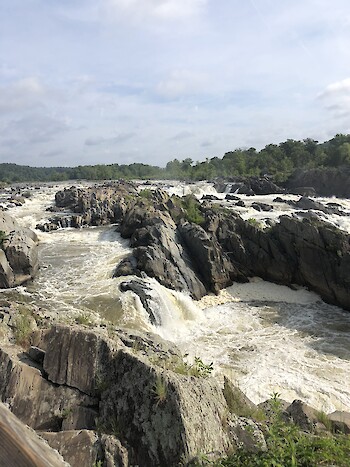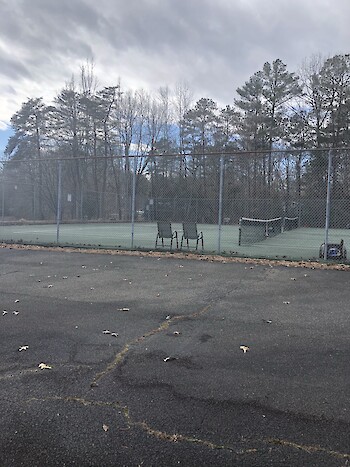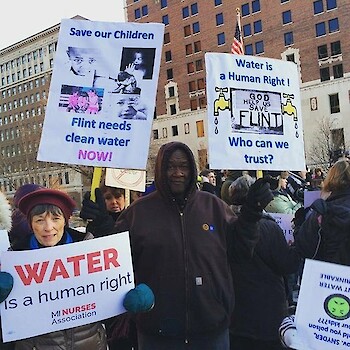Green Spaces and Environmental Justice
Sarah Jones ·
During lockdown, thanks to COVID, I will admit that I went a little nuts being in my apartment after the three-month mark. Okay. More than a little. During those times, a trip to the grocery store meant freedom from my 1,000 sq-ft apartment. There was only one activity, aside from the necessary, that everyone could do and that was getting outside.
My boyfriend and I took many walks locally at St. Mary’s River State Park. Eventually, the urge for adventure struck us, and we wanted something extravagant to gaze upon. What better place than Great Falls Park in Virginia? While being socially distant, we hiked the trails, marveled at the waterfalls, and admired all the dogs that were jumping for joy to be outside and with loved ones.
Great Falls Park and St. Mary’s River State Park are examples of green space. Green space is any piece of land that is undeveloped and is accessible to the public: parks, community gardens, playgrounds, public seating areas, and public plazas (1). Green spaces promote mental health, wellbeing, and physical health. However, low-income communities and communities of color are lacking in the quality and number of parks compared to white and wealthier communities (2,3). Why?


Socioeconomic factors are limiting the ability of certain communities to enjoy nature to decompress and exercise through green spaces. Even if there are green spaces in the communities, the quality of the parks, maintenance and safety are low such that the spaces go unused out of concern for safety (2,3). The same effect can also be observed in suburban vs. urban communities where suburban parks are more numerous and of better quality than in urban communities (4).
Green space access in communities of color has been addressed by Maryland through legislation and bills: Maryland House Bill (MD HB) 1267 and 80. MD HB 1267 focused on the issue that low-income communities and communities of color did not have equal access to shorelines and natural resources (5). MD HB 80 focused on the replacement of green spaces that were removed due to construction of the light rail (6). These two bills show the unjust reality that equality is not occurring. Unfortunately, the lack of accessibility to green spaces is not the only discrimination that these communities face.

The lack of green spaces in communities of color and low-income communities is just one aspect of environmental injustice that is occurring. These communities also must deal with a higher proportion of air pollution, lead exposure, water contamination, and chemical waste than wealthier, white communities (7). An example of environmental injustice occurred in Flint, Michigan.
The Flint, Michigan, water crisis occurred on April 24, 2014, where lead plagued water sources making it undrinkable (8,9). It was not until February 2019 that Flint’s homes had clean water running through their pipes (8). The crisis took six years to be resolved. Why? Community advocates are blaming the crisis on the demographics of Flint, Michigan where the community is mostly black (57%) and poor (40%) (10).
Growing up, I did not have to worry about not having access to parks or connecting with nature. I grew up with access to Assateague, VA, where I would play in the sand, swim in the Atlantic, go for a hike, and ride a bike. Unfortunately, communities of color and low-income communities often do not get the same advantages.
- What is open space/green space? Region 1: EPA New England. United States Environmental Protection Agency. Retrieved from https://www.epa.gov/.
- Rigolon, A. 2016. A complex landscape of inequity in access to urban parks: A literature review. Landscape and Urban Planning 153:160-169. DOI: 10.1016/j.landurbplan.2016.05.017.
- Rigolon, A., Browning, M., & Jennings, V. 2018. Inequities in the quality of urban PARK systems: An environmental justice investigation of cities in the United States. Landscape and Urban Planning 178:156-169. DOI: 10.1016/j.landurbplan.2018.05.026.
- Pearsall, H., & Eller, J. K. 2020. Locating the green space paradox: A study of gentrification and public green space accessibility in Philadelphia, Pennsylvania. Landscape and Urban Planning 195(103708) DOI: 10.1016/j.landurbplan.2019.103708.
- Maryland House Bill 1267. 2021. LegiScan. Retrieved from https://legiscan.com/.
- Maryland House Bill 80. 2021. LegiScan. Retrieved from https://legiscan.com/.
- Ranniger, G. 2020, June 1. Environmental injustice. Environmental Health News. Retrieved from https://www.ehn.org/.
- Robertson, D. 2020, December 23. Flint has clean water now. Why won’t people drink it? Politico. Retrieved from https://www.politico.com/.
- Knight, N. 2017, April 25. It’s now been three long years since Flint had clean water. Common Dreams. Retrieved from https://www.commondreams.org/.
- Martinez, M. 2016, January 27. Flint, Michigan: Did race and poverty factor into water crisis? Amsterdam News. Retrieved from http://amsterdamnews.com/.
About the author
Sarah Jones

Sarah Jones is a second year master’s student studying at the Chesapeake Biological Laboratory in Solomons, MD, with a concentration in Ecological Systems. She is studying the overwinter behavior of the blue crab, Calinectes sapidus, in the Chesapeake Bay with the help of her mentor, Dr. Thomas Miller. Sarah is working to understand the impacts of the placement of dredge material on overwintering blue crabs through mesocosm experiments and geostatistical approaches.
Next Post > Facilitating a Great Barrier Reef partnership workshop in Brisbane
Comments
-
Andrea M Miralles-Barboza 5 years ago
Love the use of imagery comparing the two green spaces you photographed, one is really green, the other?... not so much
-
Isabel Sullivan 5 years ago
Great coverage on the importance and current issues with green space in minority areas. When you mentioned, MD HB 80, I thought about the initial issue with the rail implementation: communities were not involved in this decision. Because of this, green space was destroyed and now needs to be replaced. Sadly, this is commonplace in decision-making across the U.S.
-
Taylor Gedeon 5 years ago
That's an important point you make about the quality of the greenspace, park, playground, etc, that is available to communities. Distance to greenspace doesn't provide much benefit if the park quality is poor.
-
Faith Taylor 5 years ago
I love the photo selection for this blog! It makes such a stark comparison
-
Chelsea Richardson 5 years ago
I like how you were able to combine two of the groups topics (green space and Federal EJ legislation) from class and incorporated it here.
-
Katrina Kelly 5 years ago
Sarah, I know you echo the sentiments of many of us after the COVID lockdown began to settle in. It made for a weird year. LOL! You did a great job of illustrating the features and value of green spaces for disadvantaged, often BIPOC communities. The benefit of being able to swim, hike, and be nurtured by nature is priceless and truly essential for every human's well-being, as you pointed. And, I have been a fan of Great Falls most of my life. The last time I was there, I sat on a large rock at the edge of the rapids for hours and felt absolutely renewed. Truly affordable healthcare!
-
Jehnae 5 years ago
There is definitely a need for more greenspaces in minority and low income areas. Greenspaces help promote mental health for all individuals.
-
Amber 5 years ago
As you highlighted, the quality of the greenspace is definitely of importance and often overlooked. Great job tying in current legislation. Let's hope this will be considered in projects going forward.
-
Amanda Rockler 5 years ago
Green space is of critical importance for all reasons you write about.
Dr Sacoby Wilson’s lab just released a survey to assess green space. I encourage everyone to share widely, as it is open to all people who live in Maryland.
https://umdsurvey.umd.edu/jfe/form/SV_ensnSgmDSA8qfv7 -
Olivia Wolford 5 years ago
Great summary of the green space issue, and excellent photos to compliment your discussion. I appreciate that you blended personal information along with broader statistics of the issue.
-
Nylah McClain 5 years ago
My childhood home is near the National Harbor. A certain busy area of my neighborhood didn’t have sidewalks prior to the building of the townhouses to facilitate life on the harbor. This area leads to a park that the community used regularly. Now, there are sidewalks and bike paths that lead to the park. This is makes a dangerous turn much safer to travel through.
-
Nylah McClain 5 years ago
My childhood home is near the National Harbor. A certain busy area of my neighborhood didn’t have sidewalks prior to the building of the townhouses to facilitate life on the harbor. This area leads to a park that the community used regularly. Now, there are sidewalks and bike paths that lead to the park. This is makes a dangerous turn much safer to travel through.
-
Imani Black 5 years ago
Great Falls on the MD and VA side are some of my favorite hiking spots! It saddens me that some people have yet to experience something so beautiful that's continuously untouched by man. I've had great moments in green spaces like Great Falls along my travels and I liked how you highlighted this important issues that at times doesn't get placed as a priority.
-
Peter 5 years ago
This blog makes me feel very comfortable. The stories and pictures told are very immersive. Green space is indeed an important indicator that can improve the happiness of the community. The community where I live has a wealth of facilities, but the only thing missing is a sports venue. For this reason, I often have to travel far away to exercise. , That would really hinder me. In addition, the per capita green area is too small is also an important issue.
-
Shakira 5 years ago
Sarah, you stated "Green spaces promote mental health, wellbeing, and physical health. However, low-income communities and communities of color are lacking in the quality and number of parks compared to white and wealthier communities (2,3). Why?". To be honest, I think most people know why, but I'm glad you mentioned and highlighted it to make those that may not be aware. The pictures you took were a great example of the comparisons of the different areas. Great blog!
-
Imani Wilburn 5 years ago
I had originally wanted this to be the indicator I highlighted in my own post, then I came across this one and, wow! The way you have presented this issue as well as your personal connection to the issue makes it just an amazing topic for you to cover in your blog. I believe your personal experiences really help you push this issue across and it is done so wonderfully. You really make the issues clear and present your argument so amazingly.